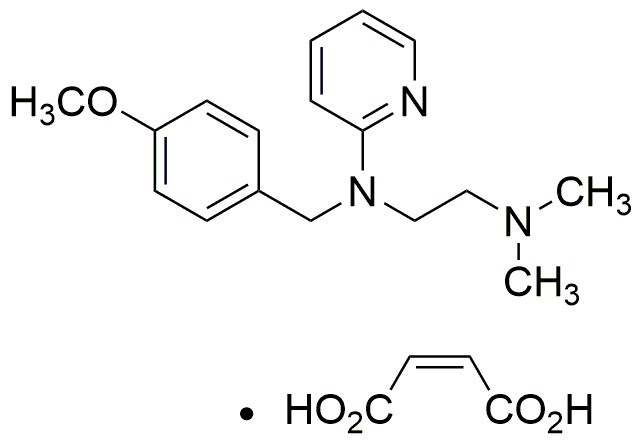Pyrilamine maleate is widely utilized in research focused on:
- Allergy Relief: Commonly used as an antihistamine, it helps alleviate symptoms of allergic reactions, such as hay fever and hives, making it essential in the pharmaceutical industry.
- Sleep Aids: Its sedative properties make it effective in over-the-counter sleep medications, providing relief for those struggling with insomnia.
- Veterinary Medicine: Employed in treating allergic conditions in animals, offering veterinarians a reliable option for managing pet allergies.
- Research Applications: Used in studies related to histamine receptor activity, aiding researchers in understanding allergic responses and developing new treatments.
- Combination Therapies: Often combined with other medications to enhance efficacy in treating various conditions, showcasing its versatility in therapeutic formulations.
General Information
Properties
Safety and Regulations
Applications
Pyrilamine maleate is widely utilized in research focused on:
- Allergy Relief: Commonly used as an antihistamine, it helps alleviate symptoms of allergic reactions, such as hay fever and hives, making it essential in the pharmaceutical industry.
- Sleep Aids: Its sedative properties make it effective in over-the-counter sleep medications, providing relief for those struggling with insomnia.
- Veterinary Medicine: Employed in treating allergic conditions in animals, offering veterinarians a reliable option for managing pet allergies.
- Research Applications: Used in studies related to histamine receptor activity, aiding researchers in understanding allergic responses and developing new treatments.
- Combination Therapies: Often combined with other medications to enhance efficacy in treating various conditions, showcasing its versatility in therapeutic formulations.
Documents
Safety Data Sheets (SDS)
The SDS provides comprehensive safety information on handling, storage, and disposal of the product.
Product Specification (PS)
The PS provides a comprehensive breakdown of the product’s properties, including chemical composition, physical state, purity, and storage requirements. It also details acceptable quality ranges and the product's intended applications.
Certificates of Analysis (COA)
Search for Certificates of Analysis (COA) by entering the products Lot Number. Lot and Batch Numbers can be found on a product’s label following the words ‘Lot’ or ‘Batch’.
Numéro de catalogue
Numéro de lot/série
Certificates Of Origin (COO)
This COO confirms the country where the product was manufactured, and also details the materials and components used in it and whether it is derived from natural, synthetic, or other specific sources. This certificate may be required for customs, trade, and regulatory compliance.
Numéro de catalogue
Numéro de lot/série
Safety Data Sheets (SDS)
The SDS provides comprehensive safety information on handling, storage, and disposal of the product.
DownloadProduct Specification (PS)
The PS provides a comprehensive breakdown of the product’s properties, including chemical composition, physical state, purity, and storage requirements. It also details acceptable quality ranges and the product's intended applications.
DownloadCertificates of Analysis (COA)
Search for Certificates of Analysis (COA) by entering the products Lot Number. Lot and Batch Numbers can be found on a product’s label following the words ‘Lot’ or ‘Batch’.
Numéro de catalogue
Numéro de lot/série
Certificates Of Origin (COO)
This COO confirms the country where the product was manufactured, and also details the materials and components used in it and whether it is derived from natural, synthetic, or other specific sources. This certificate may be required for customs, trade, and regulatory compliance.


